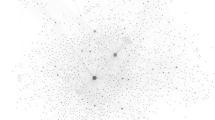Abstract
Dynamic processes in complex networks have received much attention. This attention reflects the fact that dynamic processes are the main source of changes in the structural properties of complex networks (e.g., clustering coefficient and average shortest-path length). In this paper, we develop an agent-based model to capture, compare, and explain the structural changes within a growing social network with respect to individuals’ social characteristics (e.g., their activities for expanding social relations beyond their social circles). According to our simulation results, the probability increases that the network’s average shortest-path length is between 3 and 4, if most of the dynamic processes are based on random link formations. That means, in Facebook, the existing average shortest path length of 4.7 can even shrink to smaller values. Another result is that, if the node increase is larger than the link increase when the network is formed, the probability increases that the average shortestpath length is between 4 and 8.
Access this chapter
Tax calculation will be finalised at checkout
Purchases are for personal use only
Preview
Unable to display preview. Download preview PDF.
Similar content being viewed by others
References
Kleinfeld, J.: Could it be a big world after all? The six degrees of separation myth. Society 36, 61–66 (2002)
Milgram, S.: The small world problem. Psychology Today 2, 60–67 (1967)
Travers, J., Milgram, S.: An experimental study of the small world problem. Sociometry 32(4), 425–443 (1969)
Backstrom, L., Boldi, P., Rosa, M., Ugander, J., Vigna, S.: Four degrees of separation. In: Proc. 4th ACM Int’l Conf. on Web Science, WebSci (2012)
Dodds, P.S., Muhamad, R., Watts, D.J.: An experimental study of search in global social networks. Science 301, 827–829 (2003)
Ugander, J., Karrer, B., Backstrom, L., Marlow, C.: The anatomy of the Facebook social graph (2011), accessed at http://arxiv.org/abs/1111.4503
Koohborfardhaghighi, S., Altmann, J.: How placing limitations on the size of personal networks changes the structural properties of complex networks. In: 6th Intl. Workshop on Web Intelligence & Communities (2014)
Koohborfardhaghighi, S., Altmann, J.: How structural changes in complex networks impact organizational learning performance. In: 6th Intl. W. on Emergent Intelligence on Networked Agents (2014)
Barabási, A.-L., Albert, R., Jeong, H.: Mean-field theory for scale-free random networks. Physica A 272, 173–187 (1999)
Erdős, P., Rényi, A.: On random graphs. Publicationes Mathematicae 6, 290–297 (1959)
Erdős, P., Rényi, A.: On the evolution of random graphs. Publications of the Mathematical Institute of the Hungarian Academy of Sciences 5, 17–61 (1960)
Erdős, P., Rényi, A.: On the strength of connectedness of a random graph. Acta Mathematica Scientia Hungary 12, 261–267 (1961)
Jackson, M.O., Wolinsky, A.: A strategic model of social and economic networks. Journal of Economic Theory 71, 44–74 (1996)
Galeotti, A., Goyal, S., Jackson, M.O., Vega-Redondo, F., Yariv, L.: Network games. The Review of Economic Studies 77(1), 218–244 (2010)
Rittenberg, L., Tregarthen, T.: Principles of Microeconomics (2009)
Jackson, M.O.: Social and economic networks. Princeton University Press, Princeton (2008)
Ishida, K., Toriumi, F., Ishii, K.: Proposal for a growth model of social network service. In: Web Intelligence and Intelligent Agent Technology (2008)
Bianconi, G., Barabási, A.-L.: Competition and multi-scaling in evolving networks. Europhysics Letters 54(4), 436–442 (2001)
Albert, R., Barabási, A.-L.: Statistical mechanics of complex networks. Reviews of Modern Physics 74(1), 47–97 (2002)
Davidsen, J., Ebel, H., Bornholdt, S.: Emergence of a small world from local interactions: Modeling acquaintance networks. Physical Review Letters 88(12) (2002)
Vazquez, A.: Growing network with local rules: Preferential attachment, clustering hierarchy, and degree correlations. Physical Review E 67(5) (2003)
Wilensky U.: NetLogo. Center for Connected Learning and Computer-Based Modeling, Northwestern University, Evanston, IL (1999) accessed at http://ccl.northwestern.edu/netlogo
Author information
Authors and Affiliations
Editor information
Editors and Affiliations
Rights and permissions
Copyright information
© 2014 Springer International Publishing Switzerland
About this paper
Cite this paper
Koohborfardhaghighi, S., Altmann, J. (2014). How Variability in Individual Patterns of Behavior Changes the Structural Properties of Networks. In: Ślȩzak, D., Schaefer, G., Vuong, S.T., Kim, YS. (eds) Active Media Technology. AMT 2014. Lecture Notes in Computer Science, vol 8610. Springer, Cham. https://doi.org/10.1007/978-3-319-09912-5_5
Download citation
DOI: https://doi.org/10.1007/978-3-319-09912-5_5
Publisher Name: Springer, Cham
Print ISBN: 978-3-319-09911-8
Online ISBN: 978-3-319-09912-5
eBook Packages: Computer ScienceComputer Science (R0)




